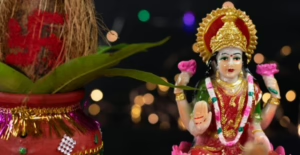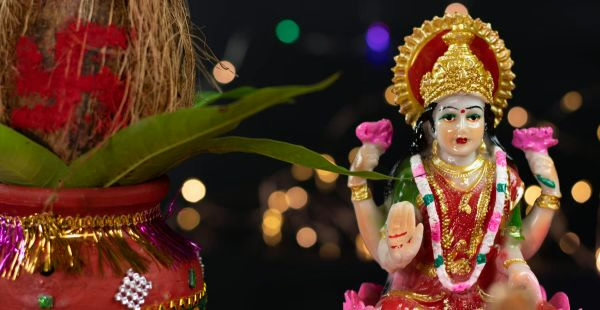
Diwali Pooja Vidhi: How the Rituals Should Be Performed:
A Practical Manual Diwali festival famous to light up the homes with lamps but at the same time they also enlighten the soul through devotion and process of rituals. To perform Diwali Pooja is a heritage of India, to celebrate Diwali and perform the Pooja is a great way to bring the luck, fortune and success in our life. For all those who need help on how to go about the Diwali Pooja, here’s your perfect guide on how to do the Pooja and the correct manner of doing it as well. And now let’s look at the spectacular practices that make this wonderful celebration a religious event.
Step 1: Purify Your Home and Heart The first and foremost thing about the Pooja that should be followed is hygiene. This festival is all about celebrating people bringing home the Goddess of wealth and prosperity, that is Goddess Lakshmi. They say she lives a clean calm life. As a first step, always clean your house and clear out any items that might slow your progress to give the new year a clean slate. One can also spread Gangajal all around the house to get the spiritual clean sweep as well as to be safe from evils. Of course, do not forget about cleaning your interior as well, your heart and your mind. Close your eyes and take a few deep breaths together with your partner as if you are wrapping up anything that could make you unhappy. The soul that has no desire of any sort of wickedness opens its arms to receive the grace.
Step 2: The pooja altar is also referred to as pooja sthaan and setting it up requires the following preparing the pooja sthaan: Your altar also known to many as the Pooja Sthaan is the stage where everything happens. Earlier people will install Lord Ganesha and Goddess Lakshmi worship idols or pictures on a raised platform with colorful flowers and preferably freshly available mango or betel leaves adornments. Spread a cloth of red or yellow colour on the platform. Place Lord Ganesha to the left to represent the god of removal of all the obstacles and place Goddess Lakshmi to the right to represent prosperity. Place a row of small clay oil lamps (diyas) and candles before the feudal lords, waiting to give them flame. Incidentally, do not forget to place on the altar a small Mghty vessel containing water and a coconut which symbolizes life force.
Step 3: Call the Deities with Prayers When your altar is set up it is now time to call on the deities into your home. Begin by chanting the Ganesh Mantra: “Om Gan Ganapataye Namah” This is followed by the Lakshmi Mantra: Om – Shreem – Mahalakshmiyei – Namah These potent mantras can be used to call on the energies of Lord Ganesha and the goddess Lakshmi into your living environment. Give them flowers, sandalwood paste, turmeric, vermilion (kumkum) and rice, as a sign of your respect.
Step 4: Offer Prasad In Diwali Pooja, the offering of Prasad particularly sweet and savory foods are of great reverence. Popular products are homemade sweets such as Ladoos, Kheer or Halwa. Off late Prasad is offered before the deity as a humble gesture in sign of thanking the gods for their blessings. It cannot be overemphasized that placing some coins or money near these idols as this goddess favors financial gains.
Step 5: Perform the Diwali Aarti songs The Aarti is the essence of the Pooja: it is the moment when the gods incarnate comes into the presence of their earthly avatar. Open the candelabras and ignites the lamps and the incense sticks, then rotate them in circular direction around the deities. Lakshmi Aarti and Ganesh Aarti are chanted in a rhythmic tone which brings in harmony and oneness to the environment. This music is about Lord Ganesha and goes like this “Jai Ganesh Jai Ganesh Jai Ganesh Deva.” “Om Jai Lakshmi Mata” As soon as the divine energy started to cover you, put your hands on the flame and put it on your head as a sign for taking the divine energy. The sound of the mantras along with the rather esthetic light of the diyas makes the environment holy.
Step 6: Offering of Naivedya (Food) Later on after the Aarti has been performed, it is also tradition for people to present a special offering to the gods. This is known as Naivedya. Cook a clean, vegan meal that has not been eaten by man and also is taken to the gods. The food is said to receive divine energy and with it those eating clean receive the Diwali blessings prayers of the gods and sustenance.
Step 7: Recite the Diwali Pooja Katha It is considered necessary to read or listen to the katha, during Diwali pooja. Occasionally, it is centered on the meaning of Diwali, which means fight between good and evil, and light against ignorance. The story of Diwali, which is believed to represent the victory of light over dark,; This is why Diwali is celebrated by lighting lamps, when Lord Dev Ram came back to Ayodhya after 14 years of exile. When reading or hearing the Katha, try to imagine what Diwali really symbolizes, namely the light within ourselves and the rejection of darkness.
Step 8: Lighting the Diyas The final moment of Diwali celebration is when diya is lit. Rise each diya after paying respects and place them in the Pooja alter as the first place and then light all the other parts of your house. The dim light emanating from the lamps can therefore be said to represent triumph of light over the darkness, learning over ignorance and faithful over despair. Some people say that when they light lamps then goddess of wealth Lakshmi enters their home and fills the home with money.
Step 9: End with a Bhajan or Prayer. Make a conscious last push to ensure you finish the Pooja on a high spiritual note – such as singing a bhajan or reading a prayer. This may be a Lakshmi bhajan, you might just sit quietly and say a prayer in which you are grateful for what you have.
Step 10: Distribute Prasad After the Performed Pooja, it is the custom that Prasad to be distributed among the family members and guests. This blessed offering contains the deities of Goddess Lakshmi and Lord Ganesha, so it’s distributed with affection and merry.
Final Thought: Embrace the Divine Light Actually, Diwali Pooja rituals is not just a custom, which has to be followed; it is actually an uplifting of divine force, and also an occasion to propitiate welfare. If and when the steps are performed with correct sadhgams, each step tunes the practitioner to the cosmic frequencies of Vak, Vakna, and Vagaha. May this diwali bring all the brightness and joy in your life and spread light to the world with all the love, peace and prosperity. Happy Diwali! May your house be shining with light, love, and may it be raining with blessings all the time.

